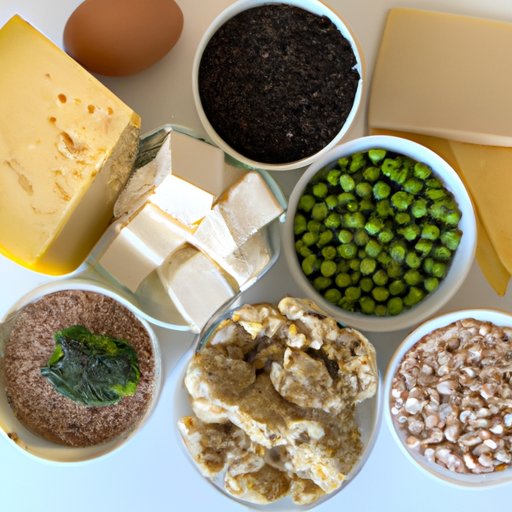
Introduction
Protein is an essential nutrient that is necessary for the growth and repair of tissues in the body. It is important to include enough protein in your diet to maintain muscle mass, support your immune system, and help you feel full. However, getting enough protein can be a challenge for some people, especially those following vegetarian or vegan diets. In this article, we will explore different ways to eat more protein and provide tips and tricks to help you incorporate it into your daily meals.
10 High Protein Foods You Need to Incorporate in Your Diet
One simple way to eat more protein is to include high protein foods in your diet. Here are ten foods that are easy to incorporate into meals and provide a good source of protein:
- Chicken breast (3 oz serving, 26 grams of protein)
- Eggs (1 large egg, 6 grams of protein)
- Tuna fish (3 oz serving, 22 grams of protein)
- Greek yogurt (6 oz serving, 18 grams of protein)
- Cottage cheese (½ cup serving, 14 grams of protein)
- Protein powder (1 scoop, 20-25 grams of protein)
- Beef (3 oz serving, 22 grams of protein)
- Salmon (3 oz serving, 22 grams of protein)
- Chickpeas (1 cup serving, 15 grams of protein)
- Peanut butter (2 tbsp serving, 7 grams of protein)
Some examples of meals that can be made using these high protein foods include grilled chicken with roasted vegetables, scrambled eggs with spinach and feta cheese, or salmon with quinoa and steamed broccoli.
How to Meal Prep Protein Rich Meals for the Week
Meal prepping is a great way to save time and ensure that you have healthy, protein-rich meals available throughout the week. Here are some tips for meal prepping:
- Choose a few high protein foods that you enjoy and that can be prepared in bulk, such as chicken breast or quinoa.
- Cook these foods in large batches and store them in separate containers for easy access throughout the week.
- Add vegetables, nuts, and seeds to your meal prep for additional protein and flavor.
- Consider making recipes that can be eaten cold or reheated, such as salads or soups.
One example of a recipe that can be meal prepped ahead of time is a quinoa salad with grilled chicken, cherry tomatoes, cucumber, and feta cheese.
The Benefits of Adding a Protein Supplement to Your Diet
Protein supplements are a convenient way to add more protein to your diet, especially if you are on-the-go or do not have time to prepare a meal. Here are some of the benefits of using protein supplements:
- Protein supplements are available in a variety of forms, such as powders, bars, and ready-to-drink shakes.
- Protein supplements are typically low in calories and can be a good option for weight loss or weight management.
- Many protein supplements are made from high quality protein sources such as whey, casein, or soy.
Some examples of protein supplements include whey protein powder, plant-based protein powder, and protein bars. When choosing a protein supplement, look for one that has at least 20 grams of protein per serving and minimal added sugars.
Surprising Plant-Based Protein Sources You’re Not Eating
Plant-based protein sources can be a great option for vegetarians, vegans, or anyone looking to incorporate more plant-based options into their diet. Here are ten plant-based foods that are high in protein:
- Lentils (1 cup serving, 18 grams of protein)
- Quinoa (1 cup serving, 8 grams of protein)
- Chia seeds (1 oz serving, 4 grams of protein)
- Pumpkin seeds (1 oz serving, 7 grams of protein)
- Tempeh (1 cup serving, 31 grams of protein)
- Tofu (½ cup serving, 10 grams of protein)
- Edamame (1 cup serving, 17 grams of protein)
- Green peas (1 cup serving, 8 grams of protein)
- Almonds (1 oz serving, 6 grams of protein)
- Spinach (1 cup serving, 5 grams of protein)
Some examples of meals that can be made using these plant-based foods include lentil soup, quinoa salad with roasted vegetables, or tofu stir-fry with broccoli and brown rice.
The Guide to Eating Protein on a Vegetarian or Vegan Diet
Vegetarians and vegans can still get enough protein in their diet by combining different plant-based protein sources throughout the day. Here are some tips for vegetarians and vegans to get enough protein:
- Combine legumes and whole grains, such as lentils and brown rice, or black beans and quinoa.
- Include soy products, such as tofu or tempeh, in your meals.
- Add nuts and seeds to your salads or as a snack throughout the day.
- Choose plant-based protein sources that are high in protein, such as edamame or hemp seeds.
One example of a plant-based meal that is high in protein is a quinoa and black bean salad with avocado, cherry tomatoes, and cilantro dressing.
Staying Full: Incorporating Protein into Snacks and Treats
Having protein-rich snacks throughout the day can help you feel full and avoid overeating. Here are some examples of protein-rich snacks:
- Hard-boiled eggs
- String cheese and apple slices
- Roasted chickpeas
- Almond butter on celery sticks
- Energy bites made with oats, peanut butter, and chia seeds
When choosing pre-made snacks, look for ones that have at least 10 grams of protein and minimal added sugars. Some examples of protein bars include Quest bars, RX bars, and KIND protein bars.
Conclusion
Eating more protein can seem like a challenge, but with a little planning, it can be easy to incorporate high protein foods, meal prep protein-rich meals, use protein supplements, choose plant-based protein options, and include protein in snacks and treats. Finding ways to eat more protein can help you feel fuller for longer and maintain your overall health.





